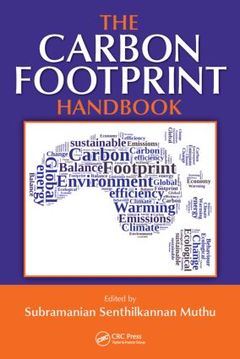Description
The Carbon Footprint Handbook
Coordinator: Muthu Subramanian Senthilkannan
Language: English
Subjects for The Carbon Footprint Handbook:
Keywords
Cf; Emission Factors; Carbon footprint; Case Study; Carbon footprint in industrial sectors; Cf Calculation; Carbon footprint modeling; Total Carbon Footprint; Carbon footprinting; Enteric Fermentation; Life cycle assessment; Functional Unit; Modeling of carbon footprint; Energy Resource; Science of carbon footprint; Raw Material; Standards and methods of carbon footprint assessment; CH4 Emission Factor; Farm Level; CH4 Emission; N2O Emission; Carbon Footprint Result; Energy Recovery; EU ETS; Carbon Emission Factors; Embodied Energy; Carbon Footprint Productivity; Specific GHG Emission; Life Cycle Interpretation; Indirect Emissions; GHG Protocol; Em Iss; ENERGY SOURCE
· 17.8x25.4 cm · Hardback
Description
/li>Contents
/li>Biography
/li>
Thorough and detailed, The Carbon Footprint Handbook encompasses all areas of carbon footprint, including the scientific elements, methodological and technological aspects, standards, industrial case studies, and communication of carbon footprint results. Written and edited by an international group of experts, the far-ranging topics on carbon footprinting are divided into three sections comprising chapters focused on methodology, modeling, and case studies.
The concepts of carbon footprint and climate change are no longer new to the world. As a result, there is increasing interest in quantifying and reducing the carbon footprint around the world, from industrial to individual levels. This book describes modeling aspects and calculations of carbon footprint in organizations and production. It emphasizes the importance of locating non-polluting energy sources as well as sustainability. The book also provides case studies offering a wealth of information on practices and methods in detecting and addressing carbon footprint.
The Carbon Footprint Handbook is an important reference that discusses, in depth, the essential details of carbon footprint assessment. It uses research and case studies on methods and practices from locations around the world including China, India, Spain, and Latin America. It demonstrates that the problems of carbon footprint are indeed worldwide while showing how they can be addressed in myriad areas of life, from industrial to personal action.
METHODOLOGICAL ASPECTS OF CARBON FOOTPRINT. The Science of Carbon Footprint Assessment. Challenges and Merits of Choosing Alternative Functional Units. Methodology for Carbon Footprint Calculation in Crop and Livestock Production. End of Life Scenarios and Carbon Footprint of Wood Cladding. Carbon Footprints and Greenhouse Gas Emission Savings of Alternative Synthetic Biofuels. Issues in Making Food Production GHG Efficient: Challenges before Carbon Footprinting. Modeling Carbon Footprint of Wood-Based Products and Buildings. Applications of Carbon Footprint in Urban Planning and Geography. MODELING ASPECTS OF CARBON FOOTPRINT. Quantifying Spatial–Temporal Variability of Carbon Stocks and Fluxes in Urban Soils: From Local Monitoring to Regional Modeling. Urban Carbon Footprint Evaluation of a Central Chinese City: The Case of Zhengzhou City. Carbon Footprint Estimation from Building Sector in India. The Carbon Footprint of Dwelling Construction in Spain. Carbon Footprint: Calculations and Sensitivity Analysis for Cow Milk Produce in Flanders, a Belgian Region. Digitizing the Assessment of Embodied Energy and Carbon Footprint of Buildings Using Emerging Building Information Modeling. CARBON FOOTPRINT ASSESSMENT—CASE STUDIES. Product Carbon Footprint: Case Study of a Critical Electronic Part (Subassembly of a Product). GHG Emissions from Municipal Wastewater Treatment in Latin America. Carbon Footprint of the Operation and Products of a Restaurant: A Study and Alternative Perspectives. Cultivation of Microalgae: Implications for the Carbon Footprint of Aqua and Agriculture Industries. Carbon Footprint of Agricultural Products. The Carbon Footprint of Sugar Production from Sugarcane in the Philippines. A Two-Phase Carbon Footprint Management Framework: A Case Study on the Rockwool Supply Chain. Product Carbon Footprint Estimation of a Ton of Paper: Case Study of a Paper Production Unit in West Bengal, India. Product Carbon Footprint Assessment of a Personal Electronic Product—Case Study of an Electronic Scale.
Subramanian Senthilkannan Muthu, PhD, currently works for SGS as a global sustainability consultant, based in Hong Kong. He earned his doctorate from the Institute of Textiles and Clothing of the Hong Kong Polytechnic University. He has more than seven years of industrial experience in textile manufacturing, testing, and sustainability evaluation of textiles and clothing materials. He has conducted many carbon footprint assessments of various products produced from various countries across the globe. He has more than 75 academic publications in various textiles and environmental journals, 10 chapters in books, about 21 books, numerous conference publications, and holds two patents. He is an editor, editorial board member, and reviewer for many international peer-reviewed journals on textiles and environmental science disciplines as well as editor-in-chief of Textiles and Clothing Sustainability Journal, an open access journal of Springer. He is also the series editor of two book series of Springer: Textile Science and Clothing Technology and Environmental Footprints and Eco-design.




